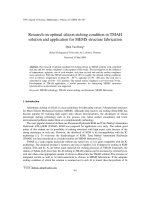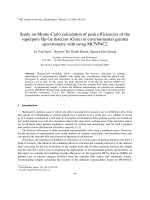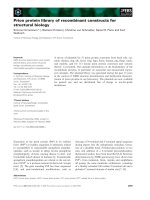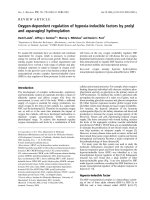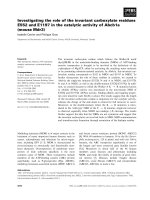Báo cáo " Research on organizing spatial production of economic models for agro - fisheries and processing industry in Diem Dien Town, Thai Thuy District, Thai Binh " doc
Bạn đang xem bản rút gọn của tài liệu. Xem và tải ngay bản đầy đủ của tài liệu tại đây (219.42 KB, 11 trang )
VNU Journal of Science, Earth Sciences 24 (2008) 32-42
32
Research on organizing spatial production of economic
models for agro - fisheries and processing industry
in Diem Dien Town, Thai Thuy District, Thai Binh Province
Dinh Van Thanh
1
, Le Van Ha
2,
*
1
College of Science, V NU
2
Institute of Social Sciences in the Centre and Highlands
Received 18 January 2008; received in revised form 12 February 2008
Abstract. The paper is focusing on the following topics:
- Assessment of natural conditions in Diem Dien Town, such as: location, relief, land, water and
marine resources.
- Research, assess human and economic resources such as population, labor skills, infrastructure,
political mechanism and consumption market.
- Analysis, assess efficiency of current producing situation and organizing agriculture, fisheries
for economic structural transition oriented industrialization and goods commodity.
- Set up spatial models of agro - fisheries and processing industry with its natural, social -
economic and human conditions and demand of goods economy, typical models of producing -
processing fruits, vegetable, seaweed and alga, and especially marine economic models.
The development of Socioeconomic in the Diem Dien in the direction of these models will
certainly yield high economic efficiency.
Keywords: Economic models; Spatial production; Agro-fishery; Diem Dien Town.
1. Introduction
*
In the attempt of driving Vietnam to be an
industrial country by the year of 2020, one
important problem is to develop highly-
specialized agriculture, which should be
combined with processing industry with
advanced technology in order to produce
consumer products, and export high quality
products [4, 8].
Diem Dien Town, Thai Thuy District, Thai
Binh Province has the Diem Dien Port which
_______
* Corresponding author. Tel.: 84-4-983760610
E-mail:
is favorable for socio-economic cooperation,
and rich soil resources and a wide variety of
seafood; and, especially, has highly potential
of water surface for sea and brackish
aquaculture, with labor resource having an
enriched mind oneself, but up to now these
advantages haven’t exploited effectively. The
main reason is the lack of understanding and
proper evaluation of potential of natural and
human resources, lack of processing
technology and especially disorganizing to
set up suitable economic models,
disconnecting closely between materials
production and consumption.
Dinh Van Thanh, Le Van Ha / VNU Journal of Science, Earth Sciences 24 (2008) 32-42
33
Consequently, researching and assessing
the developing resources for the purpose of
setting up suitable economic models on the
basis of effective use of natural and
socioeconomic advantages will help Diem
Dien Town become an urban area having a
structure of industry - agro - fishery and
trade according to its potential, contributing
to effective land use, income growth and
economic development [4, 5].
2. Resources for organizing spatial production
2.1. Geographic economic location
Diem Dien Town is located at the Diem
Ho river mouth, in the east of Thai Thuy
District, Thai Binh Province. The town is
surrounded with Thuy Trinh, Thuy Luong,
Thuy Hai and Thai Thuong communes,
which are well-known for having rich
agriculture and aquaculture production. The
river mouth of Diem Dien Town opened
through the Diem Dien seaport which is very
favorable for trading with China and
domestic regions.
Diem Dien Town has the provincial road
No. 218 and the district road No. 319 that link
the town to Thai Binh and Hai Phong cities,
which create favorable economic relations
with domestic regions and foreign countries.
The value of geographical-economic-traffic
location of Diem Dien Town is investigated to
study and use for the purpose of economic
development, Diem Dien town will take off
and become an urban with highly developed
industry, commerce and services [5].
2.2. Climate resources
The climate of Diem Dien Town has
radiation system and local hydrographic
features within the tropical zone and
circulation of atmosphere. The interaction
between these two conditions created climate
in this area that has a character of ocean
monsoon with long cold winter. The
monitored data at different weather stations
around the town have shown that the annual
average temperature is 23
0
C - 24
0
C. The
average air temperature of the coldest month
of year is 16.7
0
C, of the hottest month is 29
0
C
and the average humidity fluctuated from
80% to 84%.
The tropic and monsoon climate system
with the long winter season from November
to April creates capability to grow various
vegetation system with many tropical and
temperate plants, such as: rice, bean, peanut,
cucumber, casaba melon, and so forth.
Winter, however, with low temperature and
changeable weather rain and storms have
reduced the productivity of the crops and
domestic animals, especially, causing great
damages to seafood exploitation and
aquaculture.
2.3. Water resources
The Diem Ho River (also called Diem
Dien River) pours itself into Diem Dien
Mouth which is one of seven main river-
mouths of the Red River Delta and is also the
main river that runs through Diem Dien
Town. The hydrographic system has been
opened through to be drained at early stages,
new river routes are built for the service of
watering, draining away and traffic, and so
forth. Besides, Sing and Gu rivers are
important sources of water for agricultural
development. The water resources is
plenteous, ensuring sufficient water supply to
socio-economic development. However, it is
necessary to have methods for preserving
water sources, resistance of pollution,
saltizing, aluming, etc.
Dinh Van Thanh, Le Van Ha / VNU Journal of Science, Earth Sciences 24 (2008) 32-42
34
2.4. Soil resources
There are the two main groups of soil:
wetlands which is existed inshore; and
alkaline soil which has been formed by
influence of sea water or subterranean water
from the sea distributing over entire area of
Diem Dien Town. Agricultural land has been
used to grow food crops and vegetation, such
as: maize, lettuce, cucumber, occupying
only 21% of the total area. The uncultivated
land remains a fairly large area, including
31% of new alluvial soil which equals to 86
ha, which is distributed over an even and flat
terrain, and which can be improved to grow
farm products and develop aquaculture.
Generally, the agricultural land and
wetlands for aquaculture in this area is not
large, but it has a possibility of further
extension by improving acid soil, alkaline soil
and building dikes encroaching the sea. Due
to limited land resources, it is essential to
have a suitable land use planning, and shift
the structure of crops and domestic animal
with highly intensive cultivation, diversify
goods in order to serve the processing
industry and exportation.
2.5. Marine resources
The marine waves system changes
seasonally. From December to March, the
main wave direction offshore is northeast
which is about 61% and the eastern is about
15%. Whereas inshore it is mainly east
direction with a frequency of about 34%.
Marine wave has average height of 1.2m
(maximum of 6.6m). The altitude of inshore
waves is from 0.5m to 0.6m. From June to
September, the prevalent wave directions
over the territorial waters of Diem Dien Town
are the south, southwest, and east with the
oscillating frequency from 40% to 75%.
Meanwhile, the northern wave predominates
over about 37%. Conversely, the wave
inshore has south-east direction with average
frequency of about 24%. The highest altitude
of waves offshore is from 7 to 8 meters and
inshore is from 5 to 6 meters. The higher
levels of waves occur only when having
storms with all 8 basic directions and inshore
it is mainly east, northeast and southeast. In
the transition season from April to May, the
wave direction offshore gradually moves
from the northeast to the south, even from
October to November the wave changes in
the opposite direction, northeast direction
offshore and east direction inshore.
Especially, in the transitional stages, the
intensity of waves is decreased considerably.
The marine wave system here is favorable for
boats to exploit seafood [2].
The tidal feature of the studying area is
the tidal solar systems with high vibration
amplitude. During the day there usually
occurs the crest of tide (high water) and the
root of tide (current water). During the month,
there are two crest of tide with vibration
amplitude of water level from 2 to 4, each
period is lasted from 2 to 3 days. In the period
of the current water, the property of tidal
solar decreases obviously, but the property of
half tidal solar is increased which leads to
two crests of tide in a day. In general, the
period of tide crest is not favorable for boat to
exploit seafood offshore, but the tidal system
has a role of dynamical hydro-petrography.
In general, the salinity of sea water is very
low, which fluctuates from 9% to 17% in dry
seasons, it rarely increases up to 25-30%. In
dry seasons, the average salinity of sea water
can also reach maximum 31-32%. The sea
created the specific strength for Diem Dien
Town, that is, the capability to develop
producing branches based on the salinity of
sea water and tidal such as salt production,
Dinh Van Thanh, Le Van Ha / VNU Journal of Science, Earth Sciences 24 (2008) 32-42
35
seafood rearing, exploiting and processing.
The seafood reserve in Diem Dien is from
about 15,000 to 20,000 tons per year, and the
possible exploiting capability is about from
12,000 to 16,000 tons per year. The marine
resources of Diem Dien consist of whole high
tides area, mean tides, low tides, continental
shelf and economic zone which allows the
town to develop synthetically marine economic
branches closely connected with processing
industry at small and medium scale [2, 5].
The sea potentiality is rich, but it is urgent
to have an effective exploiting programs, and
to invest modern equipment for exploiting
offshore, and to apply technical science and
technology in order to preserve the source of
seafood, to increase catching productivity and
output. Therefore, it is necessary to study
seafood plan and processing industry in
order to achieve the highest economic effect
in order to raise income, create diversified
jobs and shift the local economic structure
according to industrialization motivation [4].
2.6. Labor resources
The development settlement in Diem
Dien Town is closely related to the history of
dykes building and land reclamation in order
to change alluvial ground into cultivated
areas in Thai Binh Province. Over the
territory of Diem Dien Town, there were
some places where the people were settled for
hundreds of years and there are some places
where people have just settled up villages
and hamlets 10-15 years ago. Today, people
who are living in the coastal zones still
continue to build dykes and land reclamation
to set up new villages and hamlets in order to
carry out the strategy of new economic
development and expand existing space to
the sea.
According to statistical data of the Diem
Dien People’s Committee of Town, by the
year of 2005, the population is 10,200 with
2,589 households; all of them belongs to the
Kinh ethnic. The households that rely on
agricultural production makes up 6.9%, on
aquaculture - 9.9%, on industrial production
and construction - 3.8%, on commerce and
service - 10%, and on handicraft - 4.4%. In
2005, the rate of labor of town made up 49.6%
of the total population, but the number of
labor having professional technical education
is only 34.1%; of which 9.3% is at primary
level, 13.8% is at the intermediate level, 3.7%
is at college level, 3.7% is at university level,
and 0.7% has master level. In general, the
quality of labor in Diem Dien is not
professional enough, and there is a lack of
labor with high skill and high-grade workers.
There is a need to train technical workers in
order to meet the requirement of shifting
economic structure.
2.7. Infrastructure conditions
The district’s traffic system has the main
provincial road no. 218 and the district road
no. 39B which links Diem Dien to Thai Binh
city. The total length of roads in Diem Dien
Town is 7.365 km, among those 5.375 km is
asphalted, the rest is stone-paved road.
Although the traffic network in Diem Dien
Town has not good enough, it meets the
requirements of transport and delivery of
goods. Diem Dien seaport, the biggest seaport
of Thai Binh Province, has a great attraction
of import and export goods, especially with
China. The town have installed electric
system, supplying and drainage water system
which ensures lighting and supplying
electricity power and clean water for
inhabitants.
Educational, healthcare and cultural
networks of the town are being invested and
Dinh Van Thanh, Le Van Ha / VNU Journal of Science, Earth Sciences 24 (2008) 32-42
36
upgraded gradually. Up to the year 2003,
primary education and junior high education
are compulsory in the whole town with 12
classes of Kinder garden, 31 classes of
primary education, 30 classes of junior high
education, one high secondary school and
one vocational training school. The hospital
of Diem Dien Town is one of the best
hospitals in Thai Binh with modern
equipments and high medical professionalism.
Information and culture system is quite
developed; there are 15 telephones per 100
inhabitants, together with a fairly developed
radio and television networks down to each
household [2].
3. Status and producing effectiveness of
economic sectors
3.1. Agriculture
3.1.1. Cultivation
Up to 2004, agricultural land area of the
whole town was 61 hectares whereas food-
produced land was 56 ha, the other was to
grow vegetables. Although productivity
increased highly, up to 2005, the average
productivity of rice is over 6 tons per hectare,
the food yield and the average annual food
per person a year is still low which haven’t
satisfied people’s living. Under the trend of
industrialization, the agriculture land is
decreased gradually, so it is necessary to
research in order to transfer from food
production to the other crops which have
economic effect not only for exporting value
but also making raw materials for food
processing , and to achieve turnover over 100
millions VND per hectare per year.
3.1.2. Breading industry
In the agriculture structure, the livestock
played a main activity which made up 35%
(in 2000), 40% (in 2003) and 42.5% (in 2004).
The breading of beeves, pig husbandry and
poultry are developing, however, the
productive scale remains small. The town’s
livestock and poultry branch have not met
local consumption and export, hence it is
necessary to choose suitable breading animals
within the limited sources of food.
3.2. Marine economic sector
The marine economic sector is key to
production of Diem Dien Town, which
accounted for 6.2% of GDP in 2004. The
marine economic consists of the branches of
catching and exploiting organism sources and
seafood processing.
3.2.1. The catching and exploiting sources of
the marine organism
The number of fishers of the town is 800
people with hard-working nature, rich
nautical and catching and processing seafood
experiences. The system of catching boats has
40 boats with power of 15 to 45 CV, 100 boats
with 46 to 90 CV, 90 boats with 90 to 320 CV
and 120 pairs of drift-net. Due to poor
equipments, fishers are impossible to exploit
seafood offshore. The main catching object is
floating fish. The output of seafood just
achieved over 6,000 tons per year
(equivalently to a half of the total capacity).
Nowadays, the town has four co-operatives
with 96 specialized workers, a private
catching company with 20 workers and 3
offshore-fishing groups with 380 workers.
The offshore fishing output achieved 1,750
tons (in 1999), 2,100 tons (in 2000), 2,500 tons
(in 2004). Although the output of seafood
increases gradually at the annual average rate
in the period of 1999 to 2004 about 8.5% per
year, the effectiveness of catching offshore by
Dinh Van Thanh, Le Van Ha / VNU Journal of Science, Earth Sciences 24 (2008) 32-42
37
boats are not high yet. The main cause is that
the fishing knowledge is still limited, the
catching net and equipment is primitive,
catching technique is backward, the serving
boat is not yet to provide cold ice, raw
materials and transport seafood to consume.
Boats with small power of motor are limited
to inshore catching, the effect is more reduced
so the fishing ground is narrow, there are
exploiting many boats, the environment is
polluted, the source of income of seafood is
exhausted. The spending on fuel, raw materials,
working wages, to repair catching means and
the time come back the offshore and inshore
catching that still is too high, and so forth.
3.2.2. Aquaculture production
Aquaculture production is one of
traditional professions of inhabitants in Diem
Dien Town. Up to 2003, the town’s seafood
aquaculture area was 8 ha, covering 2.81% of
natural land area, however, aquaculture
production is still potential and its capability
can be expanded further based on the
potential of exploitation and utilization of
tidal peak and medium zones. The
aquaculture area of water surface can be
developed up to 40 ha.
The existing aquaculture production is
natural exploitation, therefore the productivity
is low. The average productivity achieved
about 50 to 300 kg per hectare (shrimp, and
fish) and 500 to 2,000 kg seaweed per hectare.
Today, the extensive cultivation form is
gradually changing to improve intensive
cultivation form, and a small part changed to
half intensive cultivation. The main
cultivation objects are sugpo prawn, crab and
edible seaweed. The average income per
cultivated hectare is at 14 - 15 millions VND
per year. The aquaculture production output
achieves at 0.8% of the gross output of the
marine industry.
3.3. Processing industry, handicraft and service
3.3.1. Food processing
Capacity of processing industry consumed
about 50% of aquaculture production output.
The main processing product is fish sauce
which achieves from 1.5 to 2 millions liters
per year, dried fish above one million ton per
year, shrimp paste above 700 tons per year.
The total value of processing output achieved
about 15 billions VND per year. The annual
average seafood processing product achieved
more than 100 tones of frozen shrimp and
fish, and 15- 20 tones of aga.
The seafood catching, cultivating and
processing are the strong points of Diem Dien
Town in the market economy. If these
branches are invested, they will make a lot of
export products, create new jobs and help to
carry out rural industrialization and promote
other economic branches.
3.3.2. Handicraft production
A sedge mat weaving is a traditional
handicraft in Diem Dien Town. Its products
have been popular in the domestic market for
a long time because of high quality and
reasonable price, high skilled labor source. In
the recent years, due to backward technology,
lacking of invested capital and unstable
consumed markets, it has not running
effectively.
3.3.3. Maritime transport and Marine business
Since the middle of 1998, the boats have
been stopped transporting to China, some
boats shifted to domestic transportation, but
goods source was scare, and transporting cost
was low that led to low turnover the
maritime transport. The turnover of maritime
transport in 2004 reached only 3,500 millions
VND, covering 11% of the total value of sea-
Dinh Van Thanh, Le Van Ha / VNU Journal of Science, Earth Sciences 24 (2008) 32-42
38
economy sector. The main reasons of
ineffectiveness of maritime transportation
and marine business through Diem Dien
seaport are due to procedures of transporting
activities to China highly-taxed commodities
through the seaport.
Besides maritime transportation,
commercial service is also developing. In
2004, there were 250 households working
services activities, covering 12 percent of the
total number of households with turnover
above 120 billions VND annually. In general,
consuming services of industrial and
agricultural commodities have not been
developed yet because of low consumption,
which results in the town’s low economic
growth rate.
3.4. General assessment of resources and the
developing status of economic sector
The Diem Dien Town has more favorable
geographical location than other
administrative units in Thai Binh Province.
Rich soil, especially aquaculture area of salty
and brackish waters are advantageous to
economic exchanges, agricultural growth,
seafood catching and cultivating, and
maritime transportation, etc.
Together with innovation trend, Diem
Dien’s economic structure is shifting in the
direction of goods which conforms market
mechanism.
The great advantage of geographical
location of Diem Dien seaport have not been
thoroughly exploited yet. Cultivating,
breeding and processing industry did not
develop adequately to their potential,
therefore, its economic effect and value of
merchandising product are low.
The potential of water surface, agricultural
land have not been used effectively yet. It
lacks suitable forms economic models agro-
fishery that prevents manufacturing products
which can complete domestic and foreign
products.
Out of date technology is caused by
lacking of investment, high skilled labor,
consuming market, especially, unexpended
export market.
It is necessary to shift economic structure
according to industrialization and
mechanization, to organize suitable economic
models in order to effectively exploit the
potential of natural and socio-economic
resources.
4. Setting up models of spatial production
organization in Diem Dien Town
- The model of producing and processing
cucumber and vegetables. Because rice
cultivation has low productivity, it is
recommended to shift the structure of
cultivated crops by reducing area of rice and
increasing area of cucumber and vegetable
from 10 ha at present up 30 ha, to make a raw
materials for cucumber and vegetable
processing enterprises with average
productivity of 32 tons per hectare. That will
create an opportunity for surrounding
communes such as Thuy Ha, Thuy Khe, Thuy
Luong, Thuy Hai to form the areas
specializing in vegetables and supplying raw
materials for processing industry, and help to
shift agricultural structure according to the
direction of industrialization, and create more
employment and raise income (Fig. 1).
- The models of edible seaweed
cultivation and Aga processing. Edible
seaweed cultivation area up to the year 2004
was exploited with 800 ha, the area can be
increased by 20 ha by changing low effective
areas of mangrove, and shrimp pond. The
yield of edible seaweed can reach to 30,000.
Dinh Van Thanh, Le Van Ha / VNU Journal of Science, Earth Sciences 24 (2008) 32-42
39
Training
technical
staff in
charge of
cultivating
and
processing
Supplying
material
equipment,
services of
producing
consuming
and
exporting
Harvesting and
cleaning raw
materials
Boiling raw
material in alkali
environment
Bleaching alkali-
boiled product
C
ook
ing bar jelly
between 200 - 210
minutes
S
eparat
ing
product drying,
packing and
consuming
Fig. 1. Production relational model of cucumber and
vegetable caned processing.
- 40,000 tons per year (not including
source of edible seaweed in communes like
Thai Thuong, Thuy Hai and so forth). The
yield of edible seaweed harvested during a
year guarantees sufficient supply raw
materials for Aga assembly line with of 100
tone per day, which makes the capacity high
value of export product (Fig. 2).
- Marine economic model: Based on
marine resources, large seafood reserves,
favorable conditions for catching and
cultivating and, processing and maritime
transportation, Diem Dien are able to set up
and develop a comprehensive marine-economic
model.
Integrated marine economic model will
stimulate investment on aquaculture, catching,
seafood processing and maritime transport
for the purpose of thorough exploitation of
marine potentials, getting high profits,
preserving marine resources and protecting
environment. One of typical marine economic
models that has been organized and
developed effectively in Dien Diem was
cooperation of catching and fish sauce
processing [1, 3] ( Fig. 3).
Fig. 2. Model of edible seaweed processing.
5. Effectiveness of economic models
5.1. Economic effects
- Models of seafood catching and fish-
sauce processing promoted offshore seafood
catching and raised yield of seafood from
6,000 tons per year up to 8,000 tons per year.
Seafood catching can reach turnover between
600 millions VND per year and 1 billion VND
per year. Meanwhile, the fish sauce
processing can process from 2 to 5 millions
liters per a year, the turnover of 20 to 50
millions VND per year, the average income
per person from 1,000,000 to 1,500,000 VND
per month.
The area of cucumber
and vegetable
production
Raw materials
C
lean
ing
raw
material
Raw material +
salt = 10% of
raw
material
Cucumber and
vegetable-caned
product
Compressed
ice by
15% mass
of raw
materials
Compressed stone
with mass by
45
percent ma
ss of
raw materials
Dinh Van Thanh, Le Van Ha / VNU Journal of Science, Earth Sciences 24 (2008) 32-42
40
Preserved
fish
First
water
Fish r
aw materials
Fish +
salt (mass by 20
percent of mass fish)
Drwaed
water
Warmed
fish sauce
22 Be
bittern
Drawed water
>9g/l, <9g/l
End
-
product
Fig. 3. Model fish sauce processing.
- The model of Aga production from
edible seaweed materials have made high
value consuming products, replacing Aga
materials which is imported for food and
medicine processing industry, and collected
on foreign currency for the country.
- The model of producing cucumber and
vegetable that has manufacturing factories
have processing capacity of 5,000 – 6,000 tons
of casaba melon and 1,000 tons of canned
vegetable with the turnover of 100-200
millions VND per year and the average
income per person 850,000 –1,000,000 VND
per month.
5.2. Social effects
- The organizing agro-fishery processing
models have been exploited the advantages
and economic strength of the coastal
communes of Thai Thuy District, Thai Binh
Province. Economic models have brought
about a new turning-point within economic
structure by shifting purely agricultural form
to diversified and industrialized and high
value goods structure. They helped to
develop rural industrialization, create a great
variety of employment, raise income for the
unemployed and eliminate hunger and
reduce poverty for the farmers.
- Developing spatial organization of high
effective economic models have created new
awareness, and goods and market
understanding for inshore farmers of Thai
Thuy District, Thai Binh Province.
Dinh Van Thanh, Le Van Ha / VNU Journal of Science, Earth Sciences 24 (2008) 32-42
41
Fig. 4. Plan of spatial producing organization Diem Dien Town, Thai Thuy District, Thai Binh Province.
6. Conclusions
- The Diem Dien Town has great
advantages of natural resources and
economic growth. The most natural strength
of this area is the geographic location of
maritime transport, an flat alluvial ground,
fertilized soil, diversified seafood resources
which allow to set up and develop economic
structures as Agro - Industry - Fisheries and
high goods services.
- The most difficulty of the town is the
irregular climate, a lot of storms, tropical low
pressure, surplus population, un-skilled
labors, lack of investment, poor
infrastructure, out of date technology and
poor export outlets for agricultural and
marine products.
- The producing status and economic
structure have been already changed to
market-oriented economy, but its economic
structure is not really suitable. The production
still bears pure agriculture, goods are not
plentiful, and income of employee is low.
- Shifting economic structure by reducing
food production, to growing vegetables,
Dinh Van Thanh, Le Van Ha / VNU Journal of Science, Earth Sciences 24 (2008) 32-42
42
cucumber and canned vegetable for the
processing industry and exports, and by
strengthening cultivating salty and brackish
aquaculture, catching, seafood processing
and maritime transport are suitable with
objective conditions in the area and under the
trend of the rural industrialization and
raising income for farmers.
- The research of organizing economic
models such as cucumber and vegetable
processing, cultivating edible seaweed
exporting Aga processing and shrimp fish
hatching, seafood catching, processing
industry of fish sauce, and so forth, will
prove high economic effect, eliminate hunger
and reduce poverty to farmers and help to
carry out the rural industrialization and
modernization.
Acknowledgements
This paper was completed within the
framework of Fundamental Research Project
702106 funded by Vietnam Ministry of
Science and Technology.
References
[1] Le Xuan An, The planning issues for industry
development at the district level downward, The
bureau of local industry, Agricultural Publishing
House, Hanoi, 1991 (in Vietnamese).
[2] Bureau of Statistics of Thai Thuy District,
Statistical yearbook of Thai Thuy District, Thai Binh
Province for the period of 1995 - 2005, Thai Binh,
2005 (in Vietnamese).
[3] Nguyen Xuan Canh, Fish sauce processing, Hanoi
Industrial Publishing House, Hanoi, 1993 (in
Vietnamese).
[4] Diem Dien People’s Committee, Report of the
town’s Party Committee for socio-economic strategy
in the period of 2000 - 2010, Thai Thuy, Thai Binh,
2000 (in Vietnamese).
[5] Diem Dien People’s Committee, The Diem Dien
town’s developing plan in the period of 2000 - 2010,
Thai Thuy, Thai Binh, 1999 (in Vietnamese).
[6] Hanoi University, The economic resources and
territorial organization, Professional Training
Publishing House, Hanoi, 1993 (in Vietnamese).
[7] B. Huggins, D. J. Savoice, Regional development
theories and application, Transaction, New
Brunswick, 1997.
[8] W. Isard, C. Kssin, Ecologic-economic analysis for
regional development, The Free Press, New York,
1992.
